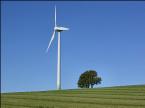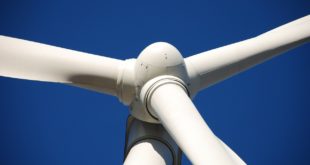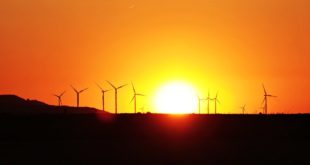Voluntary measures will help wind energy developers minimize impacts on wildlife
 WASHINGTON, D.C. – The Department of the Interior today released guidelines designed to help wind energy project developers avoid and minimize impacts of land-based wind projects on wildlife and their habitats. The voluntary guidelines will help shape the smart siting, design and operation of the nation’s growing wind energy economy.
WASHINGTON, D.C. – The Department of the Interior today released guidelines designed to help wind energy project developers avoid and minimize impacts of land-based wind projects on wildlife and their habitats. The voluntary guidelines will help shape the smart siting, design and operation of the nation’s growing wind energy economy.
“Wind energy is a key part of the Obama Administration’s sustained, all-of-the-above approach to American energy. We’re committed to working with developers to ensure that wind energy projects are built in the right places and operated in the right way,” said Secretary of the Interior Ken Salazar. “These voluntary guidelines have been developed through an intensive public process with significant help from the wind energy industry, state agencies, and wildlife conservation groups and are designed to achieve the best outcome for wildlife and wind energy development.”
Using a tiered approach, the guidelines provide a structured, scientific process for developers, federal and state agencies, and tribes to identify sites with low risk to wildlife, and to help them assess, mitigate, and monitor any adverse effects of wind energy projects on wildlife and their habitats. The voluntary guidelines, which take effect today, are designed to be used for all utility-scale, community-scale, and distributed land-based wind energy projects on both private and public lands. A fact sheet on the guidelines is available here.
“The guidelines outline a consistent and predictable approach to wind energy development while also providing flexibility to developers in recognition of the unique circumstances of each project. These guidelines reflect an enormous amount of work and care by the Fish and Wildlife Service and dozens of experts from all sides of the wind energy issue,” said Fish and Wildlife Service Director Dan Ashe. “We’ve spent years getting them right, and I believe they will help guide the responsible development of wind energy in America for decades to come.”
The voluntary guidelines released today replace voluntary interim guidelines issued by the Fish and Wildlife Service in 2003. They are the result of a five-year process that included multiple opportunities for public review and comment.
The guidelines were also informed by the Wind Turbine Guidelines Advisory Committee, established in 2007 and comprised of a diversity of stakeholders, including federal and state agencies, tribes, the wind energy industry and conservation organizations. After two years of deliberations, the committee submitted their final recommendations to the Secretary in March 2010. The Fish and Wildlife Service used the recommendations as a basis to develop their draft Land-Based Wind Energy Guidelines, announced in February 2011. After receiving more than 30,000 comments on the draft guidelines, the Fish and Wildlife Service decided to reconvene the advisory committee for additional public meetings in order to develop the most effective final guidelines.
“We know America needs more renewable energy and wind power is a key player in that mix. But conservationists can’t have it both ways: we can’t say we need renewable energy and then say there’s nowhere safe to put the wind farms,” said David Yarnold, President & CEO of Audubon. “By collaborating with conservationists instead of slugging it out, the wind power industry gains vital support to expand and create jobs, and wildlife gets the protection crucial for survival. These federal guidelines are a game-changer and big win for both wildlife and clean energy.”
“The country needs more wind energy for its American manufacturing and construction jobs, environmental benefits, and national energy security. These guidelines set the highest standard, either voluntary or mandatory, of wildlife protection for any industry,” said Denise Bode, CEO of the American Wind Energy Association. “It is our hope that in conjunction with rapid training and sensible implementation, the guidelines will promote improved siting practices and increased wildlife protection that in turn will foster the continued rapid growth of wind energy across the nation.”
The voluntary guidelines will also help developers identify additional steps, review processes and permits that may be needed to ensure compliance with federal laws such as the Migratory Bird Treaty Act, the Bald and Golden Eagle Protection Act and the Endangered Species Act. If the project may affect one or more species protected by the ESA or their habitat, for example, developers may need to develop a Habitat Conservation Plan and apply for an Incidental Take Permit.
To download a copy of the final guidelines and for other background information on the Fish and Wildlife Service’s role in wind energy development, please visit http://www.fws.gov/windenergy/.
###
 Alternative Energy HQ solar power for homes, wind energy, and bio fuel issues
Alternative Energy HQ solar power for homes, wind energy, and bio fuel issues






